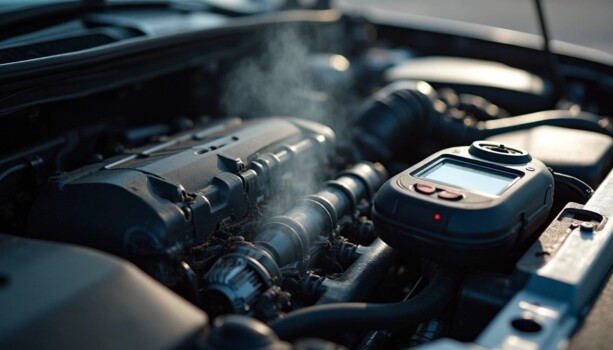Your car’s engine misfires might look like small hiccups, but they can destroy your engine if you ignore them. A simple shudder or brief power loss can quickly turn into major problems. Your catalytic converter could get damaged, costing you anywhere from $300 to $2,500 to fix.
Many drivers brush off these warning signs. They don’t realize engine misfiring creates too much heat and pressure inside the combustion chamber. Engine cylinder misfires can wreck your engine’s internal components and even cause total engine failure. Several things can make your engine misfire when idling or accelerating. Worn-out spark plugs, bad ignition coils, or clogged fuel injectors are common culprits. Recognizing engine misfire symptoms is vital – from a shaky idle to power loss or that telltale jerking feeling. The sensation of an engine misfire is something you definitely want to avoid.
This piece will help you spot engine misfire warning signs and understand why it happens. You’ll learn about the hidden damage these misfires can do to your car. It also offers practical tips to prevent and diagnose these problems before they empty your bank account and leave you stuck on the roadside.
Early Warning Signs of Engine Misfiring
Your early detection of engine misfiring warning signs can save you from repairs that get pricey later. Your car tells you about problems through symptoms you shouldn’t ignore.
Rough idle and shaking at stop
A well-functioning engine runs smoothly while you’re stopped at traffic lights. An engine with a misfire produces noticeable vibrations or shaking during idle. The engine’s unbalanced operation happens because not all cylinders fire correctly. The steering wheel might vibrate and your car’s entire body could shake. These vibrations change with engine RPM and show that some cylinders aren’t doing their part.
Loss of power during acceleration
Your car’s sluggish performance shows up when you step on the gas pedal if a cylinder misfires. The car hesitates or struggles to speed up, which creates risky situations during merging or passing. Your engine can’t reach its full power with misfiring cylinders. This leads to slower response times and weaker acceleration.
Flashing check engine light
A flashing check engine light means urgent action is needed, unlike a steady one. This warning tells you that your engine’s computer has detected a misfire in the combustion process. Your engine could suffer severe damage and use more fuel if you ignore this flashing warning. The flashing light also means unburned fuel enters your exhaust system and might damage your catalytic converter.
Jerky or uneven driving experience
Engine misfires feel like coughing or stumbling under the hood. Your car’s smooth operation gets disrupted by jerky, inconsistent power delivery. You’ll notice this jerking most while maintaining speed or accelerating because misfiring cylinders interrupt your engine’s rhythm.
Unusual exhaust smoke or smell
White smoke coming from your exhaust points to coolant leaking into the combustion chamber. A strong gasoline smell often comes with engine misfires as unburned fuel exits through the exhaust system. These strange exhaust emissions aren’t just annoying – they signal that misfiring cylinders prevent your engine from burning fuel properly.
What Causes Engine Cylinder Misfire
Engine cylinder misfires come from mechanical and electrical problems that affect the combustion process. You can fix problems quickly by understanding why it happens before they turn into expensive repairs.
Worn spark plugs or ignition coils
Your engine’s ignition system depends heavily on spark plugs and ignition coils. Spark plugs usually wear out after 80,000-100,000 miles and stop delivering the spark needed for good combustion. The ignition coils turn your battery’s low voltage into high-voltage bursts that fire spark plugs. These parts create problems throughout your engine if they fail. You’ll notice rough idling, less power, and trouble starting the engine. Bad coils make other parts work harder and wear out faster.
Clogged or failing fuel injectors
Fuel injectors must deliver exact amounts of fuel to each cylinder. Deposits build up on injectors from fuel drops that evaporate after you shut off the engine. These sticky deposits can clog the injector, mess up its spray pattern, or block fuel flow. A misfire can happen with just 8-10% blockage in one injector. The engine can’t keep steady RPM and idles roughly because of the misfire.
Vacuum leaks and air-fuel imbalance
Your engine needs a specific air-fuel ratio—usually 14.7:1 to run its best. The intake manifold or gaskets can develop vacuum leaks that let in extra air. This extra air creates a “lean misfire” because there’s too much air and not enough fuel. The engine control module gets wrong readings and adjusts the fuel mixture incorrectly.
Sensor failures: oxygen and MAF sensors
Bad oxygen sensors cause misfires by sending wrong signals to your engine’s computer. The computer adds too much fuel when an oxygen sensor wrongly shows the engine running lean, which floods the cylinders. A bad Mass Airflow Sensor (MAF) also miscounts incoming air, making the mixture too rich or too lean. Both problems lead to bad combustion and misfires.
Low compression from valve or piston damage
Your engine needs good compression to work. Worn piston rings, bad valves, or cylinder wall damage usually cause low compression. These issues stop the air-fuel mixture from compressing enough to ignite. The affected cylinder stops adding power, which makes your engine hesitate and jerk as it misfires.
Hidden Damage from Ignoring Misfires
You shouldn’t brush off an engine misfire as just a small problem. The damage builds up quietly and can cause major breakdowns at the worst possible times.
Catalytic converter overheating and failure
Bad engine misfires are the top reason catalytic converters get damaged. The exhaust system traps unburned fuel from misfires inside the catalytic converter. The converter can handle some unburned fuel, but oxygen levels and hydrocarbon concentrations rise by a lot. This creates too much heat for the ceramic substrate to handle. The extreme heat can melt or break apart the catalyst material. You’ll need an expensive replacement. Car owners usually only find this out after they fail emissions tests, which are required in all but one of these 50 states.
Increased engine wear and overheating
Regular misfires create extra heat and pressure inside the combustion chamber. This speeds up the wear on internal parts. Your engine components can warp, valves can get damaged, and pistons or cylinders might erode. The misfires mess up proper oil flow, so parts don’t get the lubrication they need. The engine starts destroying itself from the inside out. A cylinder that misfires can cause serious problems – your engine might overheat, wear out faster, or even damage the piston and cylinder surfaces.
Fuel economy drop and emissions failure
Your car’s fuel efficiency takes a big hit when misfires happen. The engine works harder because it needs to make up for the power loss from the misfiring cylinder. Cars with misfires use more fuel than they should. On top of that, hydrocarbon emissions go up. Your car might fail emissions tests even if you only see the check engine light.
Risk of complete engine shutdown
Long-term misfires can make your engine seize up completely. If you don’t fix them, the engine might hydrolock and suffer permanent damage. The good cylinders strain themselves trying to make up for the bad ones, which often causes a chain reaction of failures. Driving with a misfiring engine puts you at serious risk, especially during critical moments like passing on highways or emergency moves. This small issue can turn into a mechanical disaster quickly if you ignore it.
How to Prevent and Diagnose Misfires
Proactive maintenance and early diagnostics will help you prevent engine misfires and avoid costly repairs. You can spot potential problems before they become serious with the right diagnostic approach.
Routine spark plug and filter replacement
Regular spark plug replacement based on your manufacturer’s guidelines prevents ignition-related misfires. Your spark plugs can last anywhere from 30,000 to 90,000 miles, depending on your vehicle’s make and model. To name just one example, Toyota Corolla owners should replace spark plugs every 60,000 miles, while Toyota Sienna owners can wait up to 120,000 miles. New spark plugs maintain optimal engine performance and prevent potential misfires.
A clean air filter plays a vital role in maintaining the proper air-fuel mixture. This enhances fuel efficiency and reduces misfire risks. You should check your air filter every 3,000 to 6,000 miles to catch problems early.
Using OBD-II scanners for code reading
Your OBD-II scanner acts as the first defense line in diagnosing misfires. This diagnostic tool identifies misfiring cylinders through trouble codes in the P0300 series. To name just one example, a P0301 code suggests a misfire in cylinder #1. These scanners also monitor up-to-the-minute data like fuel trim, oxygen sensor readings, and misfire counts for each cylinder.
Compression and fuel pressure testing
Compression testing becomes significant when basic diagnostics don’t reveal the cause. This test measures each cylinder’s pressure during compression stroke to identify issues with piston rings, valves, or head gasket. Most gasoline engines should show compression between 125-175 PSI.
Fuel pressure testing helps determine if your fuel system delivers adequate pressure. Low readings often point to problems with the fuel pump, filter, or pressure regulator.
When to seek professional diagnostics
Some situations need professional expertise. A trained technician can help with inconsistent pressure readings, fuel leaks, or complex electrical issues by using advanced diagnostic tools. Your check engine light flashing indicates an urgent misfire situation that needs immediate professional attention.
Conclusion
Engine misfires may start as minor hiccups but demand immediate attention. These warning signs should never be ignored as they can cause catastrophic damage that goes way beyond occasional stuttering. Quick detection of symptoms like rough idle, power loss, and flashing check engine lights can save thousands in repair costs and prevent dangerous situations on the road.
Many car owners dismiss these warning signs. Our experience shows misfires create a chain reaction of damage throughout the engine system. Untreated misfires harm catalytic converters, speed up engine wear, and substantially reduce fuel efficiency. A simple spark plug issue can escalate into complete engine failure if you don’t address it quickly.
Your best defense against these pricey problems is prevention. Following your manufacturer’s maintenance schedule, especially when you have spark plug and filter replacements due, helps avoid most misfire scenarios. A simple OBD-II scanner investment gives you crucial diagnostic capabilities to identify issues before they become serious.
Your vehicle’s longevity depends heavily on proper engine function. Without doubt, quick responses to your car’s unusual behavior and performance issues will extend its life and maintain reliability. Your engine’s hesitation or shudder might be a small warning sign that prevents major damage in the future.
FAQs
Q1. What are the common signs of an engine misfire?
Common signs include rough idling, loss of power during acceleration, a flashing check engine light, jerky or uneven driving experience, and unusual exhaust smoke or smell.
Q2. Can ignoring an engine misfire lead to serious damage?
Yes, ignoring a misfire can cause significant damage. It can lead to catalytic converter failure, increased engine wear, overheating, reduced fuel economy, and in severe cases, complete engine shutdown.
Q3. How often should spark plugs be replaced to prevent misfires?
Spark plug replacement intervals vary by vehicle, but typically range from 30,000 to 90,000 miles. It’s best to follow your vehicle manufacturer’s recommendations for optimal performance.
Q4. Can I diagnose an engine misfire on my own?
You can use an OBD-II scanner to read error codes and identify which cylinder is misfiring. However, for complex issues or if you see a flashing check engine light, it’s best to seek professional help.
Q5. How quickly can a misfire damage an engine?
The timeline for engine damage from a misfire varies. Severe misfires can cause damage quickly, while subtle misfires may take a year or more to cause significant harm. Prompt attention to any misfire symptoms is crucial to prevent costly repairs.



